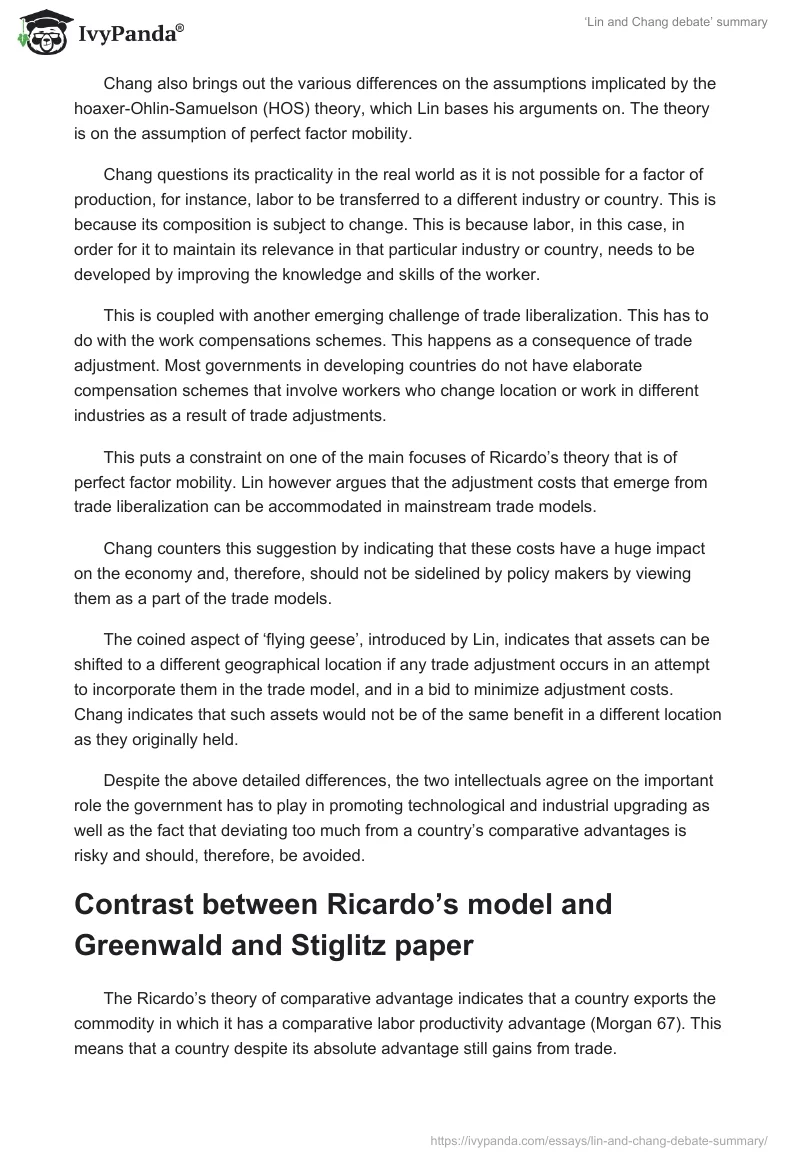The debate,’ whether policies to encourage industrial upgrading should conform to current comparative advantages or aim at missing out on the ladder’, saw a battle of brains, with the protagonists, Lin and Chang, renowned experts in their own fields engaging in a productive and healthy debate, arrived to the same conclusions while at the same time holding clashing views on the matter.
The following is a summary of the debate, emphasizing their differences as well as their emergent similarities on the issue (Lin and Chang 484).
Technological advances and industrial upgrading have taken the center stage in many development discussions with particular reference to developing economies. Both Chang and Lin agree on the intervening role of the state with regards to this matter.
However, Lin suggests the need for developing countries to import modern technology and institutions developed elsewhere and incorporate them in their system to achieve their end objective of sustained economic growth. This means that such countries should hold a comparative advantage view point, one advocated for in the Ricardo’s model.
In this case, countries should focus on industries where they can specialize in a bid to enable them compete effectively with other countries. The emphasis here is on such countries using their present factors of production such as cheap labor or natural resources, rather than wait for future factors of products such as skilled labor and capital.
Chang, however, is of a contrary opinion. He argues that a state needs to defy its comparative advantage in order to upgrade its industry.
This is because comparative advantage will help a country to achieve its short term efficiencies that deal with the efficient use of a country’s available resources, as opposed to the medium term advantage and long term development which lead to sustained growth that is the main focus of the discussion.
Chang also brings out the various differences on the assumptions implicated by the hoaxer-Ohlin-Samuelson (HOS) theory, which Lin bases his arguments on. The theory is on the assumption of perfect factor mobility.
Chang questions its practicality in the real world as it is not possible for a factor of production, for instance, labor to be transferred to a different industry or country. This is because its composition is subject to change. This is because labor, in this case, in order for it to maintain its relevance in that particular industry or country, needs to be developed by improving the knowledge and skills of the worker.
This is coupled with another emerging challenge of trade liberalization. This has to do with the work compensations schemes. This happens as a consequence of trade adjustment. Most governments in developing countries do not have elaborate compensation schemes that involve workers who change location or work in different industries as a result of trade adjustments.
This puts a constraint on one of the main focuses of Ricardo’s theory that is of perfect factor mobility. Lin however argues that the adjustment costs that emerge from trade liberalization can be accommodated in mainstream trade models.
Chang counters this suggestion by indicating that these costs have a huge impact on the economy and, therefore, should not be sidelined by policy makers by viewing them as a part of the trade models.
The coined aspect of ‘flying geese’, introduced by Lin, indicates that assets can be shifted to a different geographical location if any trade adjustment occurs in an attempt to incorporate them in the trade model, and in a bid to minimize adjustment costs. Chang indicates that such assets would not be of the same benefit in a different location as they originally held.
Despite the above detailed differences, the two intellectuals agree on the important role the government has to play in promoting technological and industrial upgrading as well as the fact that deviating too much from a country’s comparative advantages is risky and should, therefore, be avoided.
Contrast between Ricardo’s model and Greenwald and Stiglitz paper
The Ricardo’s theory of comparative advantage indicates that a country exports the commodity in which it has a comparative labor productivity advantage (Morgan 67). This means that a country despite its absolute advantage still gains from trade.
This is where the bone of contention lies with regards to a model developed by Greenwald and Stiglitz (143). This offers the main basis for the differences between the two models as explained below.
The Greenwald and Stiglitz model indicates that since the developed economy enjoys absolute advantages in the production of goods, trade is not necessary as it is beneficial to only the developing economy.
Ricardo’s model differs with this view as it indicates regardless of the absolute advantage an economy enjoys, there is a need for trade as it needs to import goods based on their opportunity cost analysis, weighing their costs and benefits.
The Greenwald and Stiglitz model takes into consideration spillover effects in different sectors of the economy such as education, agriculture, health and the like. The Ricardo’s model does not take these into consideration.
Ricardo’s model’s main theme, that of comparative advantage, provides for the sustainable growth of a country that is developed by its effort to use its already existing resources and also participate in trade in a bid to obtain resources, such as technology, from the developed countries. This contrasts the Greenwald and Stiglitz model that assumes that countries without an industrial sector cannot achieve productive growth.
Works Cited
Greenwald, Bruce and Joseph Stiglitz. “Helping infant economies grow: Foundations of trade policies for developing countries”. New Developments In macro Economics. 96.2 (2006): 141-146.
Lin, Justin and Ha-Joon Chang. “ Should Industrial Policy in Developing Countries Conform to Comparative Advantage or Defy it? A Debate Between Justin Lin and Ha-Joon Chang”. Development Policy Review. 27.5. (2009): 483-502.
Morgan, Mary. The world in the model: How economists work and think. New York: Oxford Publishers, 2012. Print.


